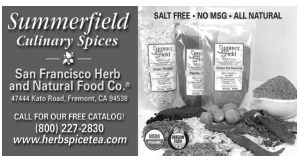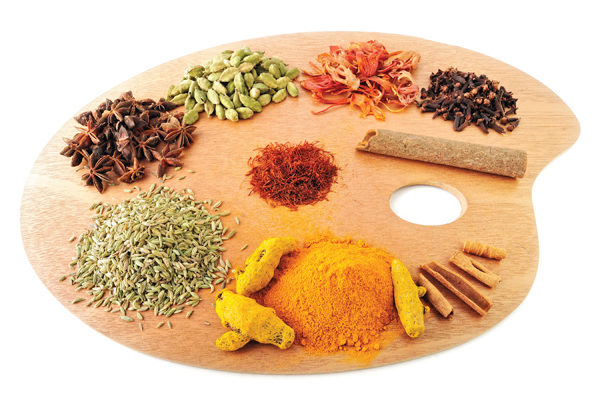From a sales standpoint, traditional Chinese medicine (TCM) and Ayurvedic medicine are becoming increasingly popular in the United States. So, as a retailer, it can prove highly beneficial to know more about these forms of medicine and some key associated herbal supplements that may benefit your customers’ needs.
A Look at Traditional Chinese Medicine
TCM tradition says humans are the center of the universe, with the world’s movement related to the yin and yang (1). The yin and yang are “opposites” and affect one another: the “yang declines and yin rises” or “yang is raised to produce a decline of yin” (1).
 This fits into the TCM view of one’s health. The bodily humors (essence, qi, blood and moisture) and internal organ systems (zang fu) play a critical part in balancing the yin and yang within the body (1). The circulation, formation and maintenance of these energies are essential for proper health. Furthermore, if the two energies are not in synch with one another, disease occurs (1).
This fits into the TCM view of one’s health. The bodily humors (essence, qi, blood and moisture) and internal organ systems (zang fu) play a critical part in balancing the yin and yang within the body (1). The circulation, formation and maintenance of these energies are essential for proper health. Furthermore, if the two energies are not in synch with one another, disease occurs (1).
Though in TCM many herbs are used, we will explore cinnamon, ginseng and licorice here.
Cinnamon has been used as a therapeutic for colds, digestive problems, nausea and diarrhea (2). A study published in the American Journal of Clinical Nutrition showed that using cinnamon may also help those with elevated blood sugar levels. In a study conducted at Malmo University Hospital, people who ate rice pudding topped with cinnamon experienced a lowering of their blood sugar levels whereas the non-cinnamon rice pudding group did not (2). Though more research is needed, it is believed that cinnamon slows the digestive process, thereby giving the body more time to break down carbohydrates, which spike blood sugar. Another study investigated the use of cinnamon in supplement form. Those with type-2 diabetes took between one and six grams of cinnamon daily. And, after one month, each showed reduced fasting blood glucose, some by as much as 29%. Triglyceride levels also were reduced by 23–30%, LDL cholesterol by 7–27% and total cholesterol by as much as 12–26% (2).
 Ginseng may offer immune-enhancing properties, which can aid in managing colds and upper respiratory tract infections, according to data published in the Canadian Medical Journal (3). The study monitored 279 Canadian subjects, ages 18–65, who reported having at least two colds the previous year (3). Subjects either took two capsules of supplemental ginseng or a placebo for four months during flu season and kept a daily log of cold-related symptoms and their severity. Researchers found, “Compared to those taking a placebo, subjects receiving ginseng experienced fewer total and recurrent colds, had fewer total symptoms per cold and suffered fewer days with symptoms.” Scientists say, however, that further research is needed to prove the results conclusive (3).
Ginseng may offer immune-enhancing properties, which can aid in managing colds and upper respiratory tract infections, according to data published in the Canadian Medical Journal (3). The study monitored 279 Canadian subjects, ages 18–65, who reported having at least two colds the previous year (3). Subjects either took two capsules of supplemental ginseng or a placebo for four months during flu season and kept a daily log of cold-related symptoms and their severity. Researchers found, “Compared to those taking a placebo, subjects receiving ginseng experienced fewer total and recurrent colds, had fewer total symptoms per cold and suffered fewer days with symptoms.” Scientists say, however, that further research is needed to prove the results conclusive (3).
Licorice Root is said to soothe bladder and kidney aliments and peptic ulcers (4). Licorice also is believed to benefit those with arthritis because it stimulates the production of the two steroids cortisone and aldosterone, which may reduce inflammation. A study published in the January 2010 issue of the Journal of Biomedical Biotechnology showed that in mice, licorice root reduced pain and swelling from arthritis and “decreased the levels of proinflammatory cytokines in serum and matrix metalloproteinase- 3 expression in the joints” (5).
 The Science behind the Medicine
The Science behind the Medicine
Now, let’s move on to Ayurvedic medicine. In Ayurveda, the universe consists of combinations of five elements: akasha (ether), vayu (air), teja (fire), aap (water) and prithvi (earth) (1). These five elements are coded into three forces (doshas), governing all life processes. When the three doshas are working together in harmony, it creates balance and health. On the other side of the spectrum, an imbalance, which can be an excess (vriddhi) or deficiency (kshaya), demonstrates a sign or symptom of affliction (1).
Keeping the doshas in balance is done, in part, with herbal Ayurvedic medicine. The following are a smattering of therapeutics used in Ayurveda.
Ashwagandha (Withania somnifera) is classified as an adaptogen, meaning that it increases the body’s ability to endure stress and has a calming effect. Researchers from Benaras Hindu University in Varanasi, India, completed an in vitro study in which ashwagandha was found to stimulate the growth of axons and dendrites (parts of nerve cells that reach out from the nerve body to communicate with various nerve cells) (6, 7). Another study completed by the University of Texas Health Science Center shows that certain extracts of ashwagandha produce GABA-like activity (gamma amino-butyric acid), an inhibitory neurotransmitter in the brain. GABA’s function is to decrease neuron activity and inhibit nerve cells from over firing.
Ginger (Zangiber officinale) is best known for soothing an upset stomach, nausea and as a therapeutic for motion sickness. To that end, some healthcare professionals have recommended ginger to those with inflammatory conditions like ulcerative colitis and arthritis, according to the University of Maryland Medical Center (8). In a 261-person study of those with osteoarthritis of the knee, people receiving ginger extract twice daily experienced less pain and needed fewer pain-killing medications, as opposed to those who received placebo (8).
Guggul (Commiphora mukul) benefits healthy cholesterol and triglyceride levels (9). The “E” and “Z” guggulsterones within this herb are the components believed to support healthy blood lipids (9). Animal studies show that guggulsterones may increase the liver’s ability to bind LDL cholesterol. Research also shows that animals given guggul and a high-fat, plaque-producing diet had lower blood fats and developed less atherosclerosis than animals that received the diet alone (9).
Gymnema (Gymnema sylvestre) is considered an excellent therapeutic because it may support healthy blood sugar levels. Gymnema sylvestre’s active compound is a group of gymnemic acids, which are said to delay glucose absorption in the blood. Furthermore, “Gymnemic acid molecules fill the receptor location in the absorptive external layers of the intestine, thereby preventing the sugar molecules absorption by the intestine, resulting in low blood sugar level,” which curbs one’s cravings for sugar (10). With respect to diabetes, gymnema leaf extract is believed to stimulate the pancreas and increase insulin release (10).
And, gymnema is said to be a therapeutic for those with asthma, inflammation and eye problems and a cough suppressant, diuretic and laxative. Although further research is needed, the compounds in gymnema are also thought to increase fecal excretion of cholesterol, as well as control obesity in the gymnema tea form (10).
Last, turmeric/curcumin (Curcuma longa) have been used both in Ayurvedic and Chinese medicine as an anti-inflammatory. It also has been used to support digestive and liver health, address skin diseases and to improve wounded skin (11). Interestingly, curcumin has been shown to stimulate the production of bile by the gallbladder (11). In addition, this powerful antioxidant reduces inflammation by lowering levels of two inflammatory enzymes (COX-2 and LOX) and keeps platelets from clumping together, thus forming blood clots (11). WF
References
1. B. Patwardhan et al.,, “Ayurveda and Traditional Chinese Medicine: A Comparative Overview,” Evid. Based Complement. Alternat. Med. 2 (4), 465–473 (2005).
2. M. Grimes, “Cinnamon Has a Long History of Healing,” www.healthnews.com/blogs/ melanie-grimes/natural-health/cinnamon-has-along- history-healing-3542.html, Aug. 9, 2009, accessed Aug. 31, 2010.
3. M. Ellis, “Ginseng: ‘Man-Root,’”www.healthnews. com/natural-health/herbal-remedies/ginseng- man-root-546.html, Feb. 28, 2008, accessed Aug. 31, 2010.
4. E. Mindell, Earl Mindell’s Herb Bible (Fireside, New York, NY, 1992).
5. K.R. Kim et al., “Anti-Inflammatory Effects of Licorice and Roasted Licorice Extracts on TPA-Induced Acute Inflammation and Collagen- Induced Arthritis in Mice,” J. Biomed. Biotechnol. 2010, 709–378 (2010).
6. R. Sahelian, “Ashwagandha,” www.healthy. net/scr/article.aspx?Id=2266, accessed Aug. 12, 2010.
7. Smart Publications, “Ashwagandha: The Indian Ginseng for Vitality and Antioxidant Protection,” www.smart-publications.com/overall_ health/ashwagandha.php, accessed Aug. 31, 2010.
8. University of Maryland Medical Center, “Ginger,” www.umm.edu/altmed/articles/ginger- 000246.htm, accessed Aug. 9, 2010.
9. The HealthCentral Network, Inc., “Guggul , ” www. h e a l t h c ent r a l . com/peoplespharmacy/408/20645.html, accessed Aug. 9, 2010.
10. P. Kanetkar, “Gymnema sylvestre: A Memoir, National Center for Biotechnology Informa t ion, ” www.nc b i .nlm.nih . g ov /pmc / articles/PMC2170951/, accessed Aug. 9, 2010.
11. University of Maryland Medical Center, “Turmeric,” www.umm.edu/altmed/articles/ turmeric-000277.htm, accessed Aug. 9, 2010.
Published in Wholefoods Magazine, October 2010









